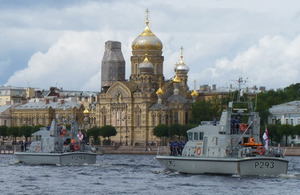Seafaring students sail to the Baltic with the Royal Navy
Students from four British universities have travelled by sea to more than 30 European and Baltic ports with the Royal Navy for 12 weeks as part of an annual summer deployment.

University Royal Naval Units' P2000 patrol vessels in St Petersburg, Russia [Picture: Crown Copyright/MOD 2012]
The students are all part of University Royal Naval Units (URNUs) which each have their own P2000 patrol vessel. The P2000s are captained by a Royal Navy Lieutenant but crewed by up to 12 young people studying at the establishment.
As well as giving them seamanship skills, the URNUs provide opportunities for personal development and often deploy for several days over a weekend to give the students time at sea.
The annual deployment sees the students, who start as officer cadets and are able to rise to the rank of midshipman, man the ship on a rotating fortnightly basis - and this year they travelled to ports including Helsinki, St Petersburg, Stockholm, Karlskrona and Kiel.
The students involved came from HMS Ranger, based at Sussex University, HMS Trumpeter at Bristol University, HMS Example at Northumbria University, and HMS Explorer from the Universities of Yorkshire - Leeds, Sheffield and Hull.
Lieutenant Hugh Harris, Commanding Officer of HMS Ranger, said:
This deployment has been a very special opportunity for the students and ship’s companies of Ranger, Trumpeter, Example and Explorer.
Due to the 1st Patrol Boat Squadron’s heavy commitment to the Olympics, deploying these four ships for an extended period of time has allowed us to maintain the delivery of sea training to not only our own URNU students but also those from other units whose ships have been deployed for Olympic security.
Over the 12 weeks we are away the four P2000s will have steamed almost 4,300 nautical miles [8,000km], visited 33 different ports in 11 countries and delivered 2,680 training days to the 200 students who have embarked.
The four ships left the UK at the beginning of June visiting Belgium, the Netherlands and Germany before transiting the Kiel Canal in mid-June and attending Europe’s largest maritime festival, Kiel Week, alongside Type 23 frigate HMS St Albans.
They then visited Murvik Naval Academy before sailing up the Swedish coast visiting a number of small towns and arriving in Stockholm. From there followed Finland, visiting Turku and Helsinki, then the Russian town of Vyborg followed by St Petersburg.
Midshipman Eilish Wells, aged 19, of Sussex University is in his first year of a biomedical science degree. He said:
This deployment has been the experience of a lifetime - without the URNU I would never have had the opportunity to travel and visit places like Russia, Estonia and Finland.
I have had my first flight on a plane, left Europe for the first time, and have loved every second. Seeing so much of the world and tying this in with learning new and valuable skills was something I never expected - it is an experience I will always treasure.
While in St Petersburg, the ships’ companies of the four P2000s were hosted at the Consul General’s house to meet local dignitaries and explain the purpose of the URNUs, with the Commanding Officers also meeting the deputy head of the Russian Naval Base on board the First World War cruiser Aurora.
From St Petersburg, the ships arrived in Tallinn, with HMS Ranger sailing to Naissaar Island, where 10 Royal Navy servicemen are buried following the island’s use by the British during the Crimean War from 1854-1855.
Students conducted a service of remembrance and laid a wreath alongside Her Majesty’s Ambassador to Estonia Chris Holtby and Defence Attache Lieutenant Colonel Ian Watts:
It was a wonderful experience to be able to attend the service of remembrance,” said Lt Harris.
The local people were exceptionally welcoming and it was a great honour to be able to lay the wreath for the 10 Royal Naval personnel involved in the Crimean War buried in this remote cemetery.
From Estonia the ships travelled to Helgoland, the Netherlands and Belgium again before they returned to the UK on 11 August.